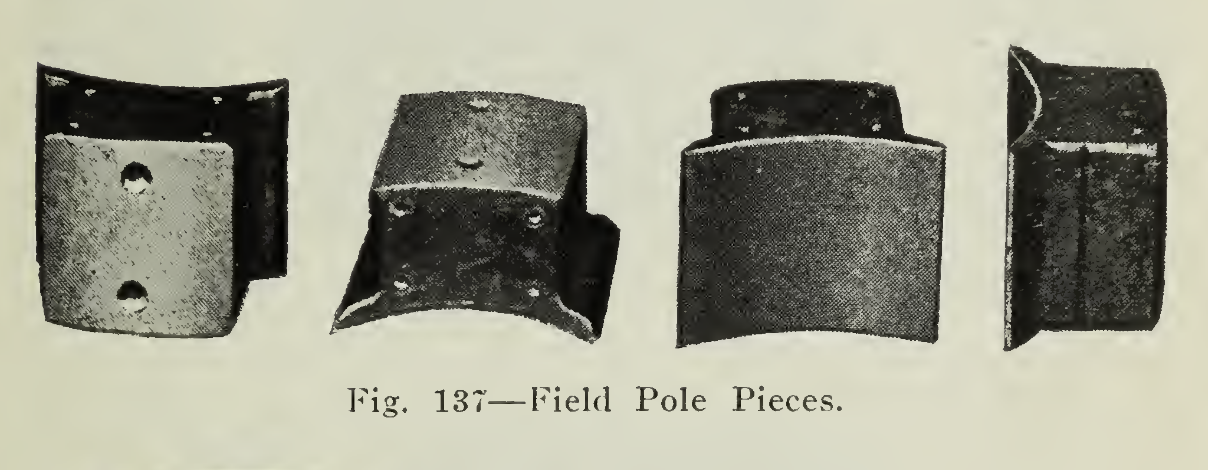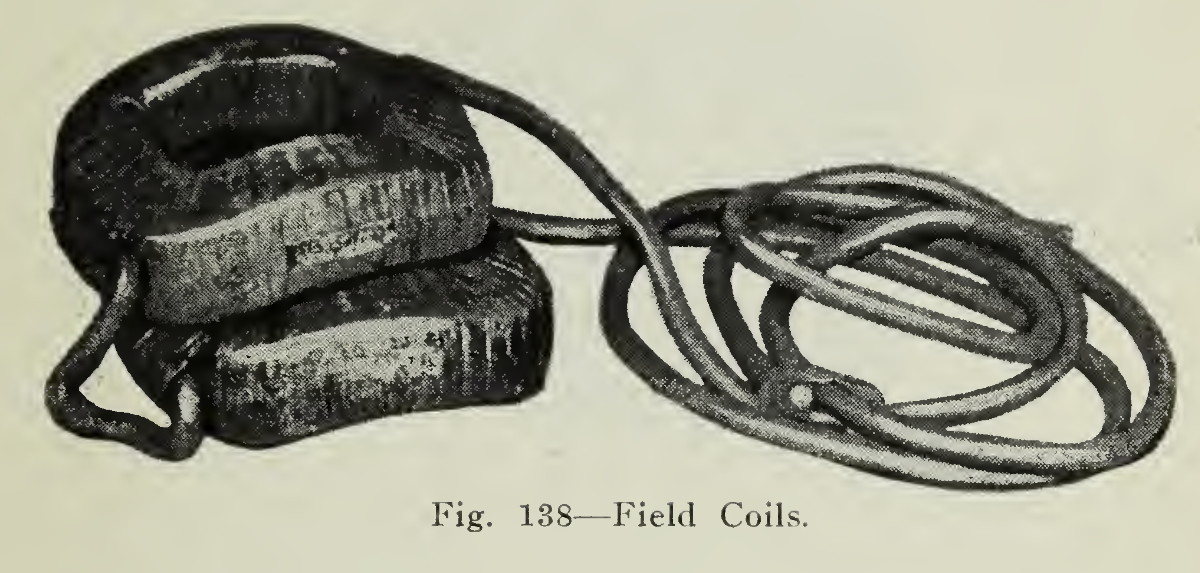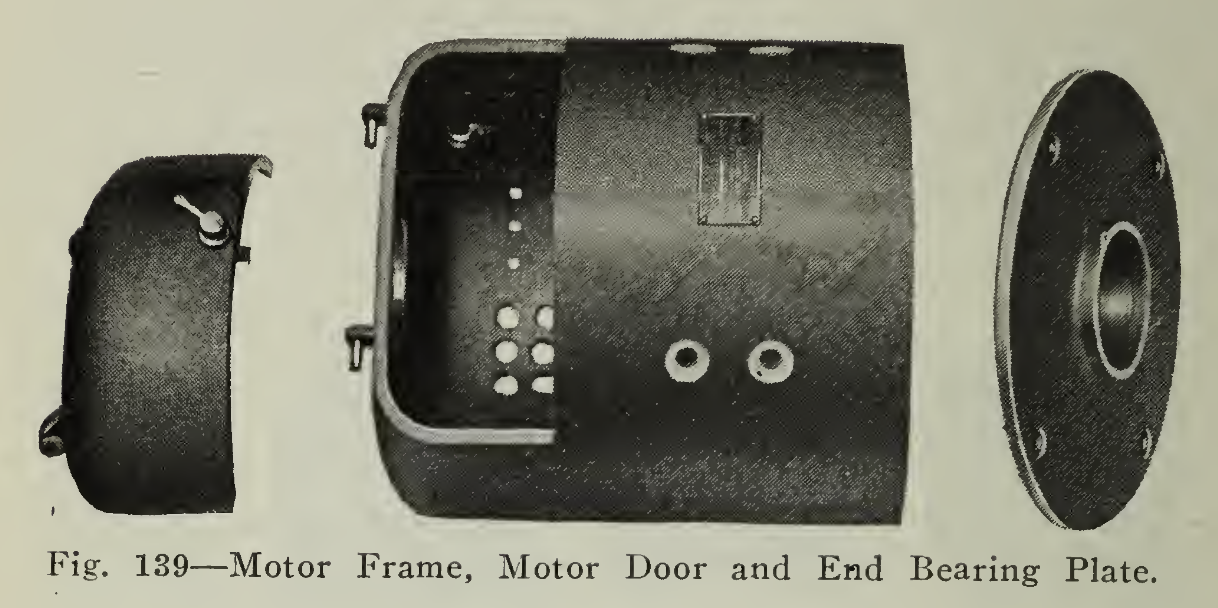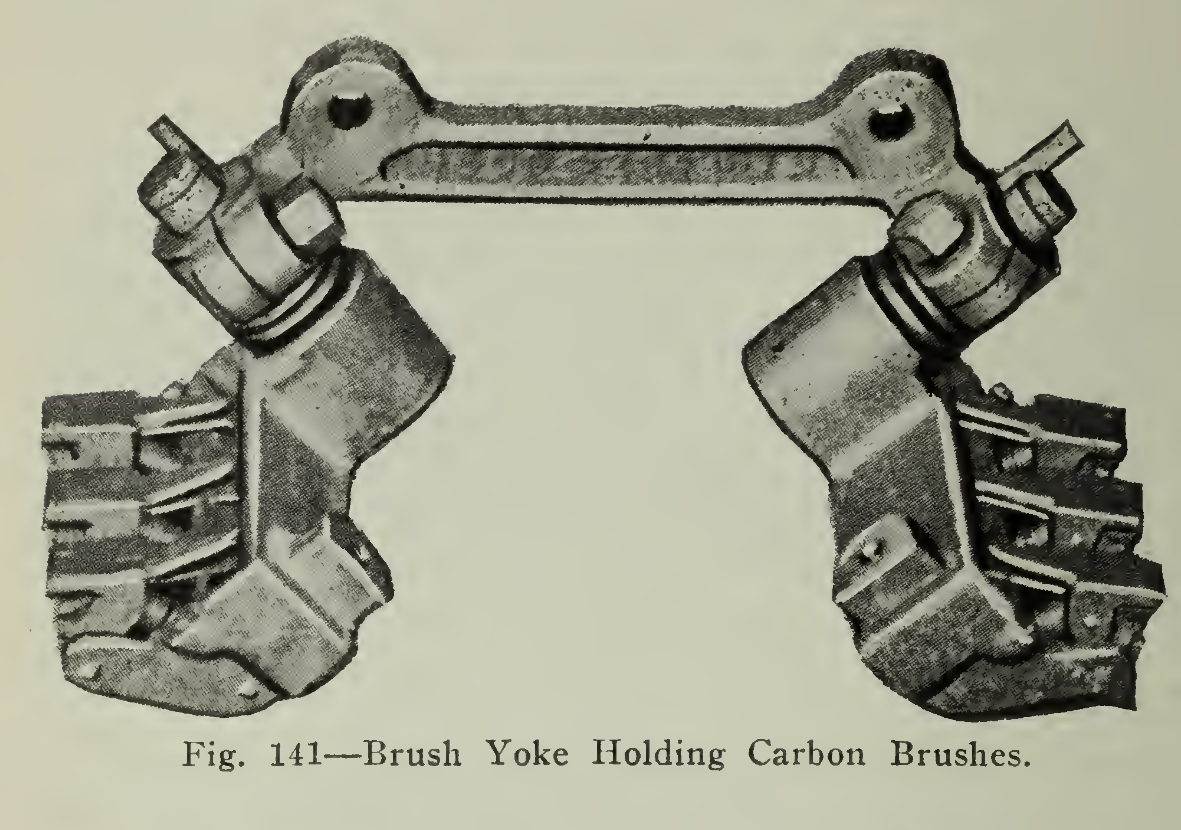Last Update: March 10, 2018

The electric motor is that part of the electric vehicle which utilizes the electrical energy furnished by the storage battery for the purpose of propelling the vehicle. The energy to the motor is regulated by the controller so that sufficient power may be furnished for operating at any desired speed up to the limit of the apparatus.
The electric motor is no doubt a very familiar and popularly used piece of apparatus, but a brief explanation will probably not be amiss at this point. The quality required in any electric motor is the ability to do a definite amount of work efficiently and immediately when called upon. In general power applications this feature has been characteristic since its introduction, and is the reason for its universal use. This characteristic is very important when applied to the functions of a motor vehicle inasmuch as it makes the operation of the vehicle simple and safe in starting, stopping and traveling. This use of the motor is not new by any means as it dates from the earliest trolley system and has progressed with it over the earth. The motor of the street railway car receives its electrical energy from the distant power house by means of a suspended trolley wire or "third rail," while the electric vehicle motor utilizes that furnished by the storage battery. The energy available from the power house is not limited as far as the needs of a single car are concerned, but, from considerations of weight and space, it is possible to supply only a limited amount from the storage battery. This restriction means that the manufacturers of these motors must not only furnish a motor capable of turning electrical into mechanical energy, but must provide one which also operates with great efficiency and which will add as little weight as possible to. the vehicle. Under ordinary conditions of operation, the power requirements are moderate, but in some instances such as heavy loads, hilly or sandy roads, the use of power many times more than normal is necessitated. The battery is capable of furnishing the energy and the motor must be capable of handling it. This is very severe service, and it may be interesting as well as instructive to point out at this time that the electric motor is practically the only machine which can be depended upon to withstand such abuse by sustaining such great overloads. The effects will be plainly evident in time, however, and so misuse should be avoided and prevented to the greatest extent. This ability to "deliver the goods," is applicable both figuratively and literally, explaining the claim of reliability and positive operation, under even adverse circumstances, without making the operating charges prohibitive. The battery must supply the energy and its ability in that direction cannot be questioned when it is known that those of central stations are sometimes called upon to supply the light and power requirements of large cities.




The motor must utilize the current to the best advantage and that this is done must be admitted when the wide application of the electric motor to every art is known. This combination of battery and motor, therefore, offer the most satisfactory and economical method of transportation, limited to safe speeds and moderate but sufficient mileage. The method is most satisfactory because of the very reasons of the electric motor; simplicity, reliability and flexibility; most economical because of the few parts, their smooth running and long life even with hard wear.
In operation, the motor depends upon the phenomena of attraction and repulsion between magnets and wires carrying currents. The magnetism is produced in this case by electromagnets, called Poles (Figs. 137 and 138), constructed of insulated copper wire coiled around cores of laminated iron. The coils and cores are always an even number, and are fastened to the inside of a steel ring known as the frame (Fig. 139). Current supplied by the storage battery to the coils, produces a powerful magnetic effect in the poles and frame; in other words sets up a magnetic field. Rotating between and almost touching the ends of the inward projecting poles, is the Armature (Fig. 140), formed of a mass of iron laminations over which insulated copper wires are wound. The wires of the armature are coiled in a plane at right angles to the plane of rotation, and their ends are soldered to a sliding contact member, the Commutator, made of copper segments insulated from each other. Current from the storage battery is conducted through the carbon Brushes (Fig. 141), and commutator to the coils of wire of the armature.


Thus, the current carried in the armature coils, by reacting upon the field, causes the armature to rotate. The Torque, or turning power of the reacting combination, varies with the amount of current in the armature and the strength of the field poles. For electric automobile purposes, the fields are connected in series with the armature, the amount of current in the armature being the same as that in the fields. This combination, known as a Series Motor, is capable of exerting powerful torque in meeting overloads. The amount of current supplied to the armature circuit determines the power developed.
This means that as the controller handle is moved into the positions signifying increased power that more current is being allowed to pass from the battery to the motor, which in turn can exert a greater turning effort. This torque delivered at the shaft of the motor to the chains or gearing, turns the wheels, thus propelling the vehicle. The power may be absorbed in two ways, by propulsion under more difficult conditions, or by increasing the speed with the same conditions. Should the car be running along a smooth, level road and the current to the motor be increased, then the effect will be to produce greater speed. On the other hand, if a grade or hill be encountered, then the speed will dimmish in proportion to the rise in elevation. This is natural as it takes more power to ascend a hill than it does to run along the level. Therefore, should it be desired not only to climb a hill but to maintain constant speed, it is evident that more power must be used, or, coming back to the motor, that more current must be furnished to it in order to accomplish the desired results. The example of the car climbing the hill is probably one which is most easily understood, but the negotiating of every sandy or muddy road amounts to approximately the same thing. This explains why the routing of a vehicle will have a direct result upon the mileage which may be secured from an electric car on a given charge. In fact, since the motor is responsive to the least whim of the operator, it also uses up the power from the battery in proportion to the length and breadth of his whims, so that a careful and considerate driver may be counted upon to secure a greater mileage with less wear and tear than one who uses up power by unnecessary or sudden stops and starts, driving through bad roads or over hills which may be avoided.
The vehicle is equipped with brakes, which may be either of the expanding or contracting type. Adjustments are always provided, generally by spring links, so that there will be no retarding action except when pressure is exerted on the brake pedals. Care should be exercised in making the adjustment so that the brakes do not drag or bind when running. It is evident that dragging brakes would cause the motor to draw a higher current than ordinarily required, and that the mileage on a charge of the battery would be thus reduced. This is one of the first places to look for trouble. If the current consumption, as indicated on the ammeter, is higher than usual for the same road conditions, then it will pay to look for dragging brakes. Naturally, this difficulty should be obviated by periodic mechanical inspection, but it is mentioned in this connection as it has so important a bearing on the motor performance.
In order to make the motor of light weight, and yet rugged in its ability to withstand heavy demands and shocks, only the best quality of iron and copper, the latter used liberally, may be utilized. Ball bearings are practically standard for reasons of low friction, reduction of bearing dimensions, quiet running and durability. They are packed with light cylinder oil, vaseline, or ball bearing grease, which requires only occasional renewal. The brush holders are conveniently located for inspection. The brushes are of carbon composition of ample capacity to operate without sparking and possess long life.
Care of Motors. As explained in the preceding paragraphs, the principles employed in the design and construction of the motors are such as to require a minimum of adjustment and inspection. The arrangement of the parts has simplicity as a special feature so that, should dismantling or repair be necessary, it may be accomplished with little delay and without disturbance of the supplementary mechanism. Being manufactured in large quantities, the parts are standardized and are interchangeable. This is of importance, for to the individual operator it means that repair parts may be readily secured and installed, and, to the operator of a fleet of vehicles, it allows practically uninterrupted service with but few extra parts or spare equipments.
Ordinarily, the motor requires no attention for months outside of lubrication and adjusting the brushes to the commutator. Inspection may be made frequently, or at least once a month, as to these conditions.
The commutator should have a highly polished smooth surface of a bluish black color. If the commutator is black or shows signs of roughening, it should be carefully polished with fine sandpaper and the dust removed. The commutator bars are insulated from each other by sheet mica, which should not extend up to the commutator surface or it will interfere with the contact of the brushes. If the mica is not undercut, however, then a thin scraper or thin hacksaw blade may be used to remove the material to a depth not exceeding 3/64". Small parts must be carefully removed from the edges of the bars.
Emery Paper Must Not Be Used on the Commutator.
The brushes should be faced to make good contact with the commutator, and move freely in the brush holders so as to allow for any inequalities in the commutator surface and have sufficient pressure on the latter. The shunts or pigtails from the brushes to the holders should be properly attached on each end. The brush holders should be securely fastened into position on the frame and spaced correctly so that there will be the correct number of commutator segments between the brushes. There are always an even number of brushes and brush holders and, for simplicity, the tendency is to use only two brush sets. There are a great many motors, however, which are supplied with four sets of brushes.
The armature should not only rotate freely in its bearings but should run with the air gap uniform between it and each pole face. Probably the majority of bearings are lubricated with vaseline or light grease, but there are some motors which are designed to use oil. Instructions with the vehicle show the treatment in such a case. To clean a bearing thoroughly, it should be washed well with gasoline, and any foreign material of hard or gritty nature removed. Lubrication is not so much a matter of soaking the machinery in oil or grease, as it is of supplying moderate amounts at regular intervals. In the modern ball bearing motor, six months is probably frequent enough to meet the usual requirements.
Cleanliness is also quite a feature in motor operation and, while the frame and covers are fitted closely so as to prevent even water from entering, yet, the motor being suspended below the vehicle, it is only natural that a certain amount of dirt should find its way into its windings. In the yearly overhauling, therefore, it should be removed. Dry compressed air of about 25 lb. per square inch pressure is admirable for blowing all dirt from the field and armature windings. If air pressure is not available, then a hand bellows may be used with good effect.
After the windings have been cleaned, they should be inspected for broken leads and defective or chafed insulation which might permit open or short circuits. The field poles should be securely locked to the frame and the field coils rigidly fastened thereto. The above instructions cover the simple items of care and upkeep required under all ordinary circumstances in the yearly overhauling. Monthly, it will usually be found sufficient to inspect the brush holders and contact with the com- mutator, and every six months to add lubricant. Like all pieces of machinery, a motor is sometimes subject to defects or faults. The most serious of these may be located as follows:
Should the motor fail to rotate when the controller is thrown into a running position, it is evidence of an open circuit or broken connection. If this is in the motor, inspection should be made to see that the brushes move freely in the holder and that no foreign material, such as paper, has found its way between the brushes and the commutator surface. An open circuit in the windings or a break in the connecting leads due to vibration or damage, is also possible and may be readily located and repaired by a competent electrician.
If there is smoke with a disagreeable pungent odor, it is indicative of burning insulation, caused by a short circuit. This will usually be shown by the motor drawing a heavy current. In such a case it is best to discontinue the operation of the vehicle until an experienced electrician has made an examination of the motor.
These faults given above are possible and do happen, so they are given here, but are found very seldom in the large number of vehicles operating daily in the hands of unskilled attendants.



